Week 47: #52 Ancestors – Soldier
By Eilene Lyon
When I recently watched portions of the film “They Shall Not Grow Old,” I was struck by how the young men (many just boys of 15 and 16), were eager to volunteer to serve in World War I. Even after all the horrors they experienced, the survivors expressed complete lack of regret for their participation.
How can it be that men and boys are so willing to be sent off to kill and die for political motives? It truly baffles me. Even stranger is when it’s someone a bit older, and married with children. I struggle to comprehend why my 3rd great-grandfather, Hiram B. Cutting, voluntarily entered the fray of the Civil War shortly after it began.
Hiram’s grandfather served during the Revolutionary War and War of 1812, so he did have that military ancestry.1 The Cuttings were Quakers, but apparently some felt called to participate if the cause seemed just.
Hiram and his wife, Mary Rowley, had four children in 1861, but that did not stop him from wanting to kick some rebel butt. The family lived in Charlotte, Vermont.2 After the war began with the firing on Ft. Sumter in April 1861, Hiram enlisted. He mustered into service at Fort Snelling, near St. Paul, Minnesota, on June 26, 1861.3

Company A of the 2nd Minnesota Regiment came mostly from Fillmore County.4 Hiram was probably in Fillmore visiting his sister and brother-in-law, Clarissa and Nahum Baker, when he enlisted. Imagine Mary receiving a letter from her husband saying that rather than coming home, he was going off to war.
Corporal Hiram B. Cutting served under Capt. Judson W. Bishop. Company A was sent to Fort Ripley in central Minnesota on July 3 to serve garrison duty. Here the men trained for their upcoming service to the Union Army. Following orders, they headed to Washington on October 14 and made it as far as Pittsburgh. There, they were redirected to Louisville, Kentucky.5 From Pittsburgh, they headed out on foot.
They marched first to Lebanon Junction, south of Louisville, then southeast to Lebanon to serve under the command of General George H. Thomas of the Army of the Ohio. They arrived in Lebanon shortly after New Year’s Day 1862. On January 19, the regiment fought in nearly hand-to-hand combat with rebel forces at the battle of Mill Spring in southeastern Kentucky.6
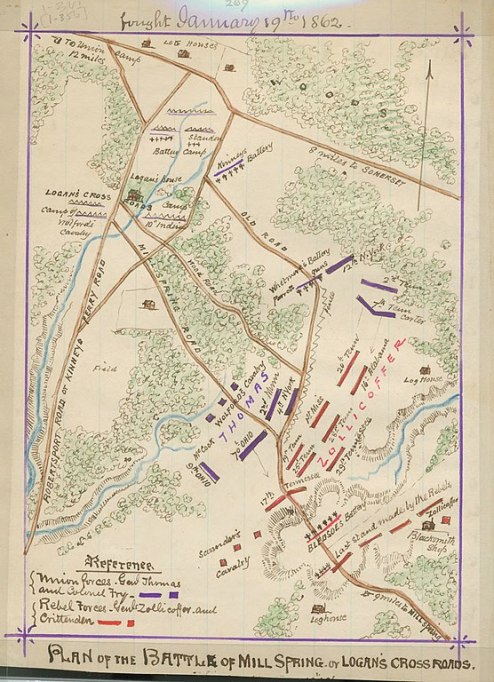
The 2nd approached a rail fence in dense fog and could not see the Confederate soldiers lying low on the other side.7 But the Minnesota regiment gained the upper hand, probably startling their opponents as well. The rebels retreated in confusion and the Union soldiers confiscated their camping gear and other supplies, which were badly needed.8
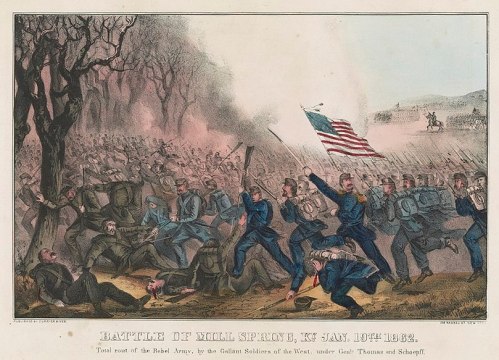
Writing home after the battle, Hiram told Mary, “We have just got back to Lebinon [sic] after 8 days march. We left Lebinon and went 80 or 90 miles and whipped the rebels…now we shall start for New Haven where we shall stop and rest.”9
Only 37 men of his company were well enough to continue fighting at that point. They had marched about 800 miles by then. Disease had taken a serious toll, but Hiram was still healthy enough to fight six days a week and Sunday, if necessary.
Hiram was optimistic after his first taste of conflict: “I think that we shall clean them out in a short time…I don’t think we shall have to fight every move as, things will be settled soon. They can’t hold out much longer. We are whipping them all of the time now.”
It’s not clear if this first battle cured Hiram of a taste for war. He wrote, “Give my love to all – tell them that my balls count every time. They say that they can’t stand the Minnesota Pills. I have waited some time for a chance at them. I have had it now.”
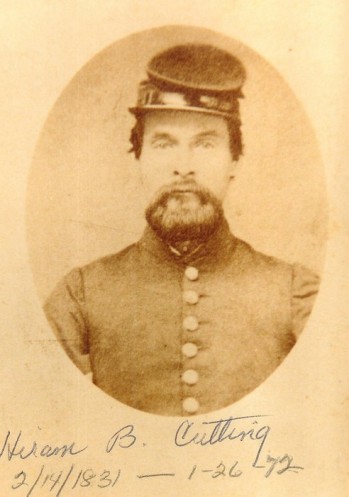
Overall, Hiram’s letter sounds upbeat and sure. He received a promotion to sergeant on July 1, 1862, though the official paperwork was not completed until December.10 The 2nd Minnesota marched all over Kentucky and Tennessee over the coming year, frequently just missing the battles and chasing Confederates more than fighting them.
They did engage in several skirmishes in the summer months. Things went much the same in the first half of 1863, with the regiment serving guard duty and camping.
In July 1863, on the eve of his regiment’s pending engagement at the Battle of Chickamauga, where they would join General Thomas and the Army of the Ohio in defending Horseshoe Ridge, a bloody conflict resulting in the wounding or death of 162 troops of the 2nd Minnesota, Sgt. Hiram B. Cutting mustered out and went home.11
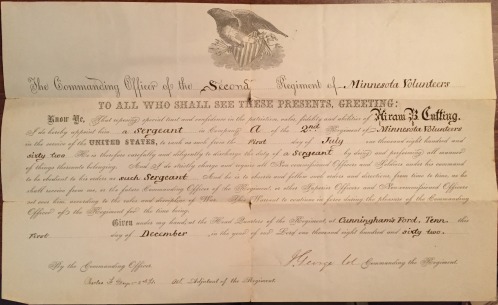
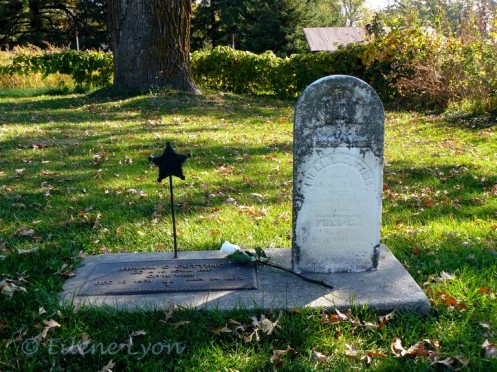
Feature image: Sgt. Hiram B. Cutting in uniform (Courtesy of N. Ingram)
Hiram B. Cutting on Ancestry.com.
- Rixford, Elizabeth M. Leach. 1991. Three Hundred Colonial Ancestors and War Service. Clearfield Company, p. 70. ↩
- Mary Cutting. Year: 1860; Census Place: Charlotte, Chittenden, Vermont; Roll: M653_1319; Page: 234; Family History Library Film: 805319 – via Ancestry.com. ↩
- Letter from the State of Minnesota Adjutant General’s Office, dated December 22, 1955, collection of N. Ingram. ↩
- 2nd Minnesota Volunteer Infantry Regiment. Ancestry.com. Minnesota, Civil War Records, 1861-1865 [database on-line]. Provo, UT, USA: Ancestry.com, Operations, Inc., 2011, image 64. ↩
- 2nd Infantry Regiment Minnesota, report by James George, Comdg. Second Minnesota Volunteers. Historical Data Systems, comp. U.S., American Civil War Regiments, 1861-1866 [database on-line]. Provo, UT, USA: Ancestry.com Operations Inc, 1999. ↩
- Ibid. ↩
- https://www.mnopedia.org/group/second-minnesota-volunteer-infantry-regiment ↩
- James George, see note 5. ↩
- Transcript of letter from Hiram B. Cutting to his wife, from Lebanon, KY, dated February 21, 1862, collection of N. Ingram. Location of original unknown. The following paragraphs from this same source. ↩
- Certificate from Col. J. George, commanding officer of the 2nd Regiment, collection of N. Ingram. ↩
- Minnesota in the Civil and Indian Wars 1861-65Minnesota Adjutant General’s Report of 1866. Historical Data Systems, comp. U.S., Civil War Soldier Records and Profiles, 1861-1865 [database on-line]. Provo, UT, USA: Ancestry.com Operations Inc, 2009. ↩

Like you, I have trouble understanding the enthusiastic desire to go into battle. I do wonder what his wife thought. Were you able to find any letters she sent him?
LikeLiked by 2 people
I have not seen any letters beyond this one. I am planning to request a copy of Mary’s pension application, which might shed more light on this period of their lives.
LikeLiked by 2 people
I don’t understand it either. I can see young men with no other prospects being attracted to the army (still happens), but a husband and father? I’d have thought he would have seen his duty elsewhere.
LikeLiked by 2 people
Excellent point, Anabel. It’s hard to fathom. If he’d been drafted, that would be a different story, but he wasn’t.
LikeLiked by 2 people
Hiram sounded like a very matter-of-fact kind of fellow, that he’d just go off and take care of this fighting business and then go home.
LikeLiked by 2 people
LOL. He sure did think they’d make quick work of those rebs!
LikeLiked by 1 person
Our government has always been quite effective when it comes to wrapping war up in a patriotic bow. Having interviewed veterans of WW2 and Vietnam, I was awed by their humility as well as their belief that it was their calling.
LikeLiked by 1 person
Still, it’s hard to wrap my head around this whole idea, especially when one has a family to support.
LikeLiked by 1 person
This is true.
LikeLiked by 1 person
I believe it was from a deep sense of duty and love of country that would bring many young men to answer the call of war. This was lost somewhat after the Vietnam war and all that it brought on us. Also it has only been in very recent times that the true horrors of war could be brought right into a person’s home almost as it happens. Why do you think they keep news people away from the action as much as they do. Just a few years ago young people had no idea. However I fear we have not yet learned these lessons.
LikeLiked by 2 people
Thanks for such a thoughtful comment. I know from my research that war was glorified in many ways in society. It’s a shame that people have not evolved to solve conflicts without resorting to violence. And as the world gets more crowded and resources scarcer, it will likely continue.
LikeLike
Yep, you really would think that a man old enough to have four children would be sensible enough not to voluntarily enlist! Especially a Quaker! I do love They Shall Not Grow Old though.
LikeLiked by 1 person
I couldn’t watch the whole thing – much too gruesome and sad. But the enhanced film footage is sooo amazing.
LikeLiked by 1 person
I read something recently about MN and the civil war. They were the youngest state, but the first to send troops. There was a real sense of pride, I’m sure Hiram felt it.
I’m like you though – it just baffles me.
LikeLiked by 1 person
MN did have an overwhelming number of volunteers right off the bat and quickly filled their quota. They had a plenty waiting to join when the 2nd regiment was finally authorized. But Hiram didn’t even live in the state! (though he did move there a later)
LikeLiked by 1 person
For sure
LikeLike